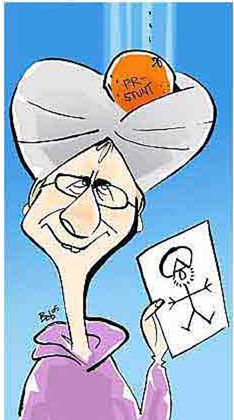
Europe Backpeddles Over Danish Cartoons
Religious and political leaders stepped up efforts to defuse the growing tensions between Muslims and Christians, as demonstrations continued across the Islamic world against the cartoons of Muhammad.
Pope Benedict XVI announced a three-day visit in November to Turkey, where the murder of a Catholic priest has been linked to the outrage caused by the Danish cartoons.
Father Andrea Santoro, 60, was shot in the back on Sunday as he knelt to pray in Trabazon in eastern Turkey.
His suspected killer, a teenage boy, is reported to have told police he was incensed by the cartoons…
FRONTLINE/WORLD . Dispatches . Dispatches . Denmark: Art and Religion Collide | PBS — This report which was published last December outlines much of the controversy over the Danish Cartoons — a situation that began in September and suspiciously resurfaced in the last few weeks. I find this very peculiar. Also this article goes into all sorts of details left out by the major media. For example:
In Kashmir, thousands of businesses reportedly shut down for a day in early December to protest the cartoons. (A reaction that left most Danes I spoke to perplexed). And according to the Danish Foreign Ministry, the youth group of Pakistan’s largest Islamic party, Jamaat-e-Islami, posted an $8,000 bounty on the lives of the cartoonists.
“That’s like $600 a head. You’re not going to get anyone in Denmark to kill anyone for $600,” comedian Omar Marzouk told me at a cafe one afternoon. “That’s my Pakistani brothers, though. They’re so cheap.”
MarzoukMarzouk is a first-generation Egyptian-Dane who has made a successful living challenging the political correctness that he believes prevents Danish society from engaging in honest dialogue, especially when it comes to his country’s immigrant community.
Marzouk’s comedy cuts both ways. He’s as likely to offend radical right-wingers as radical Muslims. (He posts death threats he receives from both camps on his Web site).
related links:
The Times of India Comes Out On Side of Muslim Protests
The right to freedom of expression is not an absolute right. All rights, legal and moral, come with responsibilities that contextualise them.
A right can qualify to be so only if it is exercised with responsibility, to the individual and society. The right to freedom of expression can be no exception.
The current controversy over cartoons featuring Prophet Mohammad misses this point. Certainly, that does not justify the violent response to the insensitive depiction of Islam.
But to defend an act that has provoked people across the world to react with indignation, under the ruse of freedom of expression, is to misunderstand the right.
And here’s an interesting Muslim perspective which hints at the possibilities that some other forces are at work while condemning the cartoons. I found this background paragraph particularly distressing though:
This is not a new proposition. It has always been a balancing act between competing rights.
That’s why Jyllands-Posten’s publication of the offensive drawings was “juvenile,” in the apt phrase of a New York Times editorial. That’s why most dailies in Canada and the U.S. have refused to reprint the cartoons (not because they are “afraid,” as some polemicists say).
Were they juvenile? In a huge story such as this shouldn’t the public judge for itself? I personally didn’t find them to be offensive or juvenile and thought a couple were typical of editorial-style cartooning — a little offensive to the target. But that’s their design. Are Muslims off-limits?
When there is news coverage of an event causing worldwide havoc and hand-wrining you can’t just ignore or supress the source of the anger in a cavalier manner. Not in Western society under any circumstances. That’s unless you want the populace to be befuddled and stupid.
That said, it’s apparent to me that this sort of suppression is a trend and a growing one.

Troublemaker, moi?
Final related link:
Are Extremists fanning the Outrage? Syria, Iran and others behind the reemergence of this controversy?
The country’s supreme leader, Ayatollah Ali Khamenei, said in a nationally televised speech that the cartoons were part of a “Zionist plot.” Mohsen Rezai, an official on the Expediency Council — a powerful body of hard-line clerics — said the drawings were a “test” by the West to see what Muslims’ reaction would be.
Iranian state media depict the drawings as an act of the Danish government, not a private newspaper. “After insulting Islam with the drawings, the government has not apologized yet,” one newsreader said in a television broadcast recently.
















The newspapers aren’t showing the pictures because they’re worried about their employees or themselves getting hurt, but they’re not willing to admit it and are instead using excuses of offense or taste. These same newspapers never had any problem printing anti-Jew or anti-Christian ‘art’.